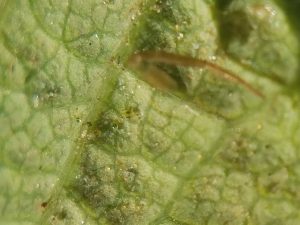Evan Anderson, Walton County Agriculture Agent
 Strawberries are currently in full production, and seeing rows of beautiful berries at a u-pick operation, or flats of flawless fruits in the store makes it easy for the consumer to forget how many pests and diseases growers must deal with. Strawberries take a great deal of management to produce, and part of that management is dealing with insects and other arthropods. While not all of them find the berries themselves to be delicious, these pests can nevertheless damage a crop to the point of significant financial loss.
Strawberries are currently in full production, and seeing rows of beautiful berries at a u-pick operation, or flats of flawless fruits in the store makes it easy for the consumer to forget how many pests and diseases growers must deal with. Strawberries take a great deal of management to produce, and part of that management is dealing with insects and other arthropods. While not all of them find the berries themselves to be delicious, these pests can nevertheless damage a crop to the point of significant financial loss.
The major arthropod pests North Florida strawberry growers deal with include the tarnished plant bug, two-spotted spider mites, thrips, aphids, and various types of caterpillars. There is no one treatment that is effective for the control of all these pests, so proper scouting is necessary to identify what is present on the crop. Once the problem has been identified, the correct control method can be chosen.


Tarnished plant bugs, Lygus lineolaris, spend the winter as adults, hiding wherever they can find shelter from the weather. They lay their eggs on a variety of host plants, which include strawberries, and complete their life cycle in three to four weeks. Since they feed on so many different plants, and go through three or four generations each year, control may be difficult. Removing host weeds such as goldenrod and dog fennel from the surrounding area may help. Pesticides such as pyrethrins, acetamiprid, bifenthrin, or carbaryl can be used to control tarnished plant bugs as well.

The two-spotted spider mite is a tiny arachnid that can build up huge populations on strawberry crops, especially during hot, dry weather. They are often found on the underside of leaves, and may require a hand lens to be seen. They pierce plant tissues and suck out its juices, causing leaves to appear yellow and stippled. Home gardeners may be able to use an insecticidal soap or horticultural oil to control spider mites, but larger producers may need a miticide such as abamectin or acequinocyl.
Chewing damage on flowers or leaves may be caused by caterpillar pests. Armyworms, cutworms, and corn earworms are just a few such pests that may be found attacking strawberry plants. Pesticides containing Bacillus thuringiensis or azadirachtin can be effective for caterpillar control.
There may also be biological controls available for larger scale growers. The release of predatory or parasitic insects can help reduce the population of harmful arthropods. Lacewings, ladybugs, pirate bugs, and parasitic wasps have all been used to attack harmful pests on strawberries.
For more recommendations on the control of strawberry pests, utilize the following links to fact sheets, or contact your County Agriculture Agent.
Strawberry Production (Chapter 15: Florida Vegetable Production Handbook)
Growing Strawberries in the Florida Home Garden
 0
0
